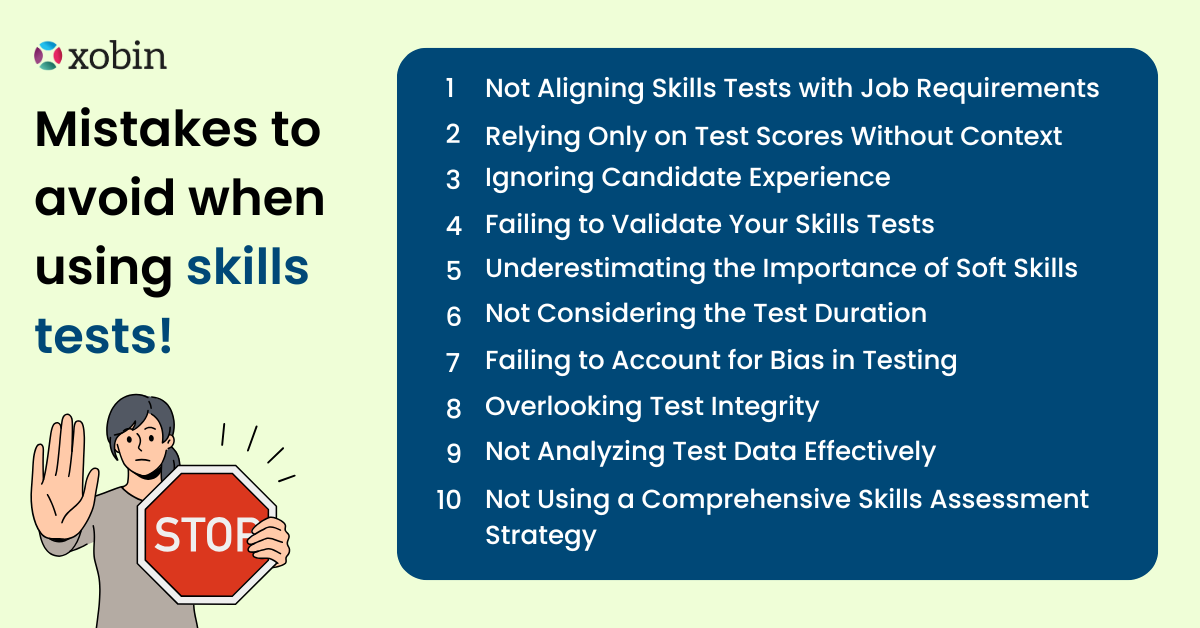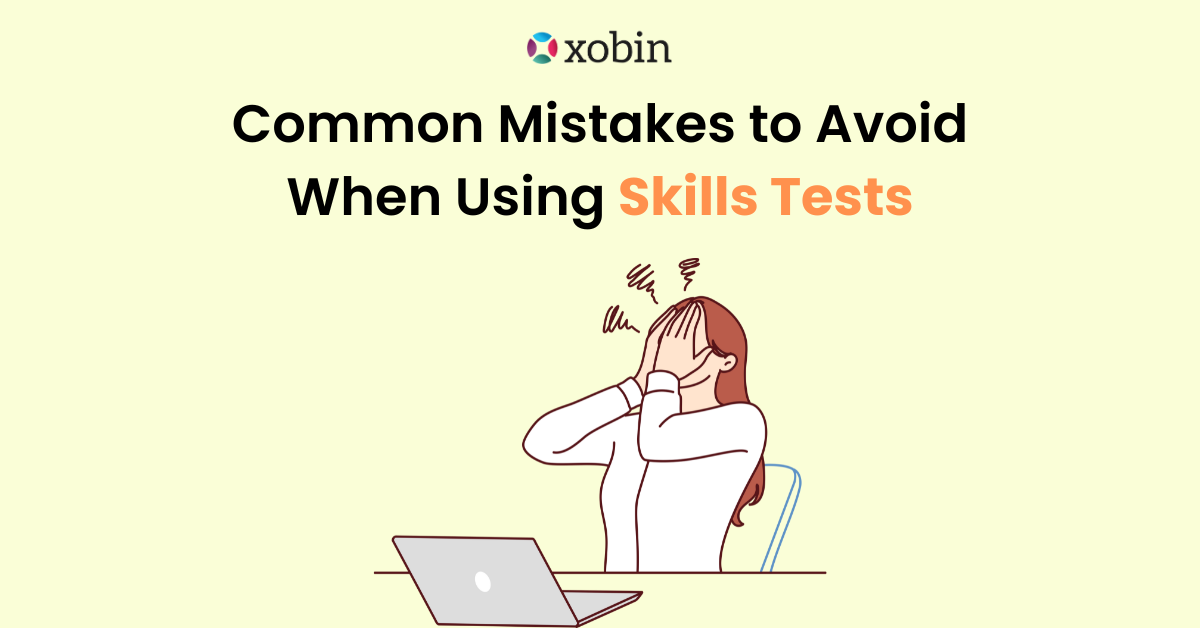In the fast-paced world of recruitment, every hire counts. But how do you ensure your hiring decisions are based on the right skills and capabilities? The answer often lies in skills assessment tests. These assessments provide an objective way to evaluate candidates, helping you select the right talent for your organization. However, despite their many benefits, recruiters sometimes make common mistakes when implementing these tests, which can lead to ineffective results or a poor candidate experience. Understanding these pitfalls can help you make the most of skills tests and improve your hiring process.
Let’s dive in and explore the mistakes to avoid when using skills tests!
Table of Contents

1. Not Aligning Skills Tests with Job Requirements
Recruiters often use generic skills tests that do not assess the actual skills required for a specific job. This results in hiring the wrong candidates or rejecting qualified ones. A poorly chosen test can lead to mismatched hires, affecting team productivity and increasing turnover rates. For Example, Imagine you’re hiring a software developer and use a basic coding test that focuses on theoretical programming knowledge rather than practical problem-solving. The candidate who scores the highest may be great at memorizing syntax but might struggle with real-world coding tasks.
How to Avoid It?
- Identify must-have skills for the job before selecting a test.
- Customize the skills test to assess practical job-related tasks.
- Use role-specific assessments. For instance, a content writer should be tested on grammar, SEO knowledge, and creativity rather than general English proficiency.

2. Relying Only on Test Scores Without Context
Many recruiters make hiring decisions solely based on skills test scores without considering additional factors like work experience, cultural fit, or learning potential. While scores provide valuable insights, they don’t tell the whole story about a candidate. For example, A company is hiring a sales executive and selects candidates solely based on a sales aptitude test. However, the top-scoring candidate struggles in real-world client interactions due to poor communication skills, leading to performance issues.
How to Avoid It?
- Use skills tests as part of a holistic hiring process, not the only factor.
- Consider work experience, behavioral interviews, and reference checks alongside test scores.
- Look at candidate potential. A slightly lower test score may not matter if a candidate has strong motivation and adaptability.

3. Ignoring Candidate Experience
A skills test that is too long, complex, or unclear can frustrate candidates and cause them to drop out. If the assessment process is unpleasant, even top talent may lose interest. For Example, A candidate applying for a customer service role is asked to complete a skills test that takes over 90 minutes without any prior notice. They abandon the test and apply to a competitor instead.
How to Avoid It?
- Keep tests between 30-45 minutes to respect candidates’ time.
- Clearly communicate what the test involves and why it matters.
- Ensure tests are mobile-friendly so candidates can complete them easily.
- Provide feedback post-assessment so candidates feel valued.

4. Failing to Validate Your Skills Tests
Using unverified skills tests can lead to hiring biases, unreliable results, and legal issues. If a test isn’t properly validated, it may fail to predict actual job performance. For Example, A company hires an HR manager based on a personality test that isn’t scientifically validated. The new hire performs poorly, leading to costly turnover.
How to Avoid It?
- Use assessments backed by scientific research and psychometric properties.
- Regularly review test results to ensure they correlate with job performance.
- Choose skills test software that offers pre-validated tests and benchmarking data.

5. Underestimating the Importance of Soft Skills
Focusing only on technical skills while ignoring soft skills like communication, leadership, and teamwork can lead to hiring candidates who struggle in collaborative environments. Technical expertise alone isn’t enough to ensure long-term success in a company. For Example, A company hires a data scientist based on their excellent test scores. However, the candidate struggles to present insights clearly to stakeholders, affecting team collaboration and decision-making.
How to Avoid It?
- Include soft skills assessments alongside technical tests.
- Use situational judgment tests to evaluate decision-making and interpersonal skills.
- Assess cultural fit through behavioral interviews.

6. Not Considering the Test Duration
When using skills tests as part of the recruitment process, it’s easy to get caught up in the results and forget about the candidate’s experience.
Too long: Candidates drop out.
Too short: The test fails to evaluate skills properly
For Example, An entry-level sales position requires candidates to take a 2-hour assessment, causing frustration and high drop-out rates.
How to Avoid It?
- Keep assessments under 45 minutes whenever possible.
- Break long tests into shorter sections or multiple rounds.
- Monitor completion rates and adjust test length accordingly.

7. Failing to Account for Bias in Testing
Some skills tests unintentionally favor certain groups, leading to biased hiring decisions and reducing workplace diversity. If a test includes cultural or gender-based biases, it can unfairly disadvantage certain candidates. For Example, A verbal reasoning test includes idioms and cultural references that non-native English speakers may struggle with, leading to lower scores despite strong communication skills.
How to Avoid It?
- Use bias-free assessments that focus on job-related skills.
- Regularly audit test performance data for potential biases.
- Implement blind scoring where assessors do not see candidates’ names, gender, or background.

8. Overlooking Test Security
If skills tests lack security measures, candidates may cheat, leading to unreliable hiring decisions. For Example, A company conducts an online coding test but does not implement proctoring. Candidates copy answers from external sources, leading to the hiring of individuals who cannot actually code.
How to Avoid It?
- Use web proctoring to prevent cheating.
- Implement question randomization so no two candidates get the same test.
- Set time limits to reduce the chance of looking up answers.
9. Not Analyzing Test Data Effectively
Many recruiters focus only on test scores without analyzing broader performance patterns. Simply looking at pass or fail results doesn’t provide a full picture of a candidate’s potential. Ignoring detailed insights can lead to missed hiring opportunities or ineffective assessment strategies. For instance, A company uses a skills test to assess digital marketing candidates. The test data shows that many applicants struggle with SEO-related questions but perform well in content strategy. However, since the recruiter only looks at the final scores, they fail to identify this pattern. As a result, they miss the chance to refine their test or provide targeted training for new hires.
How to Avoid It?
- Look beyond test scores, analyze trends, skill gaps, and candidate strengths.
- Use assessment data to improve future hiring strategies.
- Compare test results with on-the-job performance to refine assessments.
10. Not Using a Comprehensive Skills Assessment Strategy
Many recruiters make the error of using skills tests as the sole deciding factor in hiring. While pre-employment assessments are valuable, they should not replace other essential evaluation methods like interviews, reference checks, or work samples. For example, a recruiter hires a sales executive based on their excellent test score in negotiation and communication. However, after joining, the new hire struggles with teamwork and adaptability, leading to poor performance.
How to Avoid It?
- Combine skills tests with structured interviews.
- Include behavioral and situational judgment tests to evaluate real-world decision-making
- Include work samples or case studies for roles requiring hands-on expertise.
Hire Smarter Using Xobin’s Skills Assessment Test!
- Create Custom Assessments: Craft tests in 3 easy ways—Search the assessment library, Generate with Job Description, or Build from Scratch.
- Tailored to Your Needs: Add different sections to evaluate multiple skills for each candidate. No more one-size-fits-all tests!
- Randomized Questions: Shuffle questions within sections for a personalized test experience for every candidate.
- Massive Question & Test Library: Access 180,000+ tech and non-tech questions and 3400+ skills tests and 2500+ job role-based tests. Plus, create your own from scratch!
- Advanced Proctoring Features: Keep assessments secure with Off-Tab Activity Tracking, Webcam Proctoring, Eye Gazer Proctoring, and AI-powered Proctoring.
- Set Clear Criteria: Add timers, enable off-tab activity tracking, and set cut-off criteria to ensure fair evaluation.
- Diverse Assessment Types: Choose from MCQs, coding challenges, typing tests, subjective questions, and assignments to test a wide range of skills.
- Easy Candidate Invitations: Invite candidates by sending a personalized assessment link, or bulk invite via CSV upload—hassle-free!
- Real-Time Evaluation: With Xobin’s automated scoring and reporting, get actionable insights instantly, making hiring faster and smarter..
Don’t let common recruitment mistakes hold you back. If you want validated, bias-free, and secure skills tests, explore our skill inventory. Switch to Xobin and start hiring smarter, faster, and better. Book a personalized demo today!






